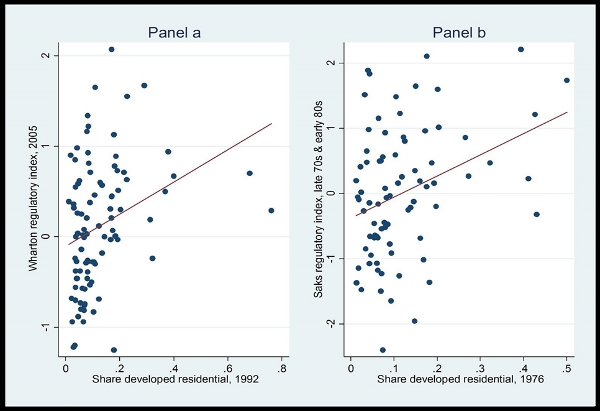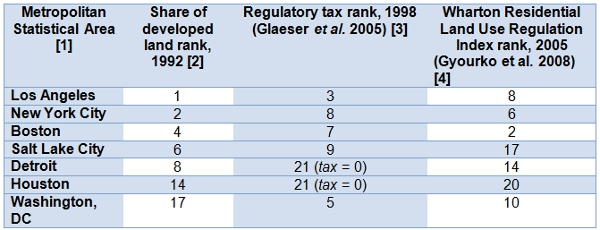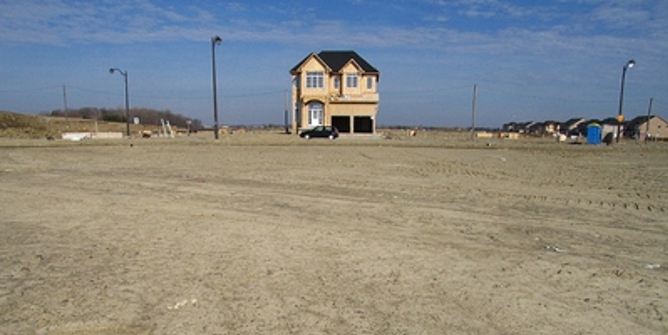
 In the US and elsewhere, zoning policies and other land use regulations are now widespread. Christian Hilber and Frédéric Robert-Nicoud look at the reasons behind these policies, finding that, driven by lobbying from developers and property owners, places that are more developed tend to adopt tighter land use regulations. With land regulations operating as a form of ‘shadow tax’, of over 50 per cent of housing value in some cities, land regulations may now have become too much of a barrier to development in urban areas.
In the US and elsewhere, zoning policies and other land use regulations are now widespread. Christian Hilber and Frédéric Robert-Nicoud look at the reasons behind these policies, finding that, driven by lobbying from developers and property owners, places that are more developed tend to adopt tighter land use regulations. With land regulations operating as a form of ‘shadow tax’, of over 50 per cent of housing value in some cities, land regulations may now have become too much of a barrier to development in urban areas.
Land use regulations vary tremendously in shape and scope across space and have become more widespread and stringent over time. Although land use regulations have a long history dating back to the 17th century at least, they were initially pro-growth. Only one century ago, hardly any country regulated land use systematically in a restrictive manner. The first comprehensive zoning law in the United States, for example, dates back to 1916 (in New York). In contrast, nowadays all modern states regulate land use intensively in an overwhelmingly restrictive way.

Land use planning policies can, in principle, raise welfare by correcting market failures. Recent evidence, however, casts doubt on this proposition and suggests that such regulations have strong adverse net effects: Turner, Haughwout, and van der Klaauw (2012) estimate the net cost of land use regulations as a proportion of land value to reach a hefty 38% in their sample of residential plot transactions across the United States. An earlier study by Cheshire and Sheppard (2002) estimates the net costs of land use planning policies in the UK to amount to as much as 3.9% of annual household incomes. So we are talking about big numbers.
These big numbers hide substantial heterogeneity. Glaeser, Gyourko and Saks (2005) estimate that land use regulations are akin to a ‘shadow’ tax that represents over 50% of the values of houses in Manhattan and San Francisco, a fifth in DC and Boston, 12% in NYC or Salt Lake City, and zero in Detroit, Baltimore, and Houston (see Table 1, col. [3]). Likewise, Cheshire and Hilber (2008) estimate the regulatory tax for 14 British and 8 continental European office locations. The average shadow tax, over the sample period, amounts to a staggering 800% of marginal construction costs in the London West End, 437% in Frankfurt, 97% in Newcastle, and 68% in Brussels.
This heterogeneous regulation of land use begs the question: who benefits from tight land use controls? Prime suspects are land- and homeowners: by restricting supply, land use regulations raise house prices and the price of already developed land. In his influential book, William Fischel postulates that homeowners elect local politicians who implement policies that protect the value of their most important asset – their home. The so called ‘homevoter hypothesis’ implies that local regulations reflect the wishes of the majority. Consequently, local jurisdictions that house a large fraction of homeowners are predicted to be more regulated than jurisdictions that host only a few; empirical evidence at the local level backs this hypothesis. The bitter consequences of higher house prices are felt by newcomers, potential or real, who are disenfranchised. But disenfranchised does not necessarily imply powerless.
In a recent paper (Hilber and Robert-Nicoud, 2013), we formalize a theory in which land use regulations reflect land based interests, more broadly defined, following the pioneering work of the sociologist Harvey Molotch. These land based interests encompass those of homeowners but also include those of landlords and those of absentee landowners. This is consistent with the idea that planning boards are amenable not just to the electorate but also to lobbying influence and to pressures from various interest groups. Solé-Ollé and Viladecans-Marsal (2011) and Schone, Koch, and Baumont (2011) provide indirect empirical evidence for the relevance of lobbying by land developers in Spain and France, respectively. The conviction of former Baltimore mayor Sheila Dixon for taking bribes from developers in 2009 suggests that such pressures can also take malign forms.
We also uncover novel evidence across US cities (Metropolitan Statistical Areas, or MSAs, in the jargon) that the extent and breadth of regulations is positively associated with urban development. The former is quantified by the Wharton Residential Land Use Regulation Index (WRLURI) computed by Gyourko, Saiz, and Summers (2008) for the 93 largest US MSAs in 2005; the latter is defined as the fraction of land in 1992 that is amenable to urban development (buildings and roads) that is actually put to urban use. Insofar as regulations increase the cost of living, they reduce the equilibrium population and the share of developed land relative to the laisser-faire. Put differently, this economic mechanism implies a negative relationship between land use regulation and urban development. Yet, the data for the US robustly suggests otherwise (see Figure 1, panel a): the share of developed land in 1992 is positively associated with the extent of regulation pertaining in 2005. A similar pattern was already visible in earlier data from the late 1970s (see Figure 1, panel b): the share of developed land in 1976 is positively related to a regulatory index compiled for the late 1970s.
Figure 1 – Unconditional correlation between regulatory restrictiveness and
share developed residential land

Our theory is consistent with this empirical finding. In our framework, owners of developed residential land favor additional land use constraints as this raises the price of their land; owners of undeveloped land oppose such tightening because it increases the cost of development. Mobile households evaluate heterogeneous local amenities, such as access to a major ocean cost or January temperatures, and housing costs (which also reflect local regulation) and pick locations accordingly. The model leads to two key equilibrium relationships: first, places with desirable amenities are more populated and their land is more developed than that of less desirable places. Second, places that are more developed adopt tighter land use regulations. Table 1 and the patterns in Figure 1 provide casual evidence for the positive relationship between local amenities and the city-wide share of developed land, and between the share of developed land and the extent of land use regulation, respectively.
Table 1 – Development and Regulation Rankings for a subsample of
a selection of 21 US MSAs, 1990s

Using more comprehensive, systematic, and rigorous econometric techniques, we find that both theoretical predictions are consistent with patterns we uncover in a cross-section of 93 major US cities. The effect is also quantitatively meaningful. To fix ideas, compare Salt Lake City (the 56th most regulated MSA in our sample) to San Francisco (16th). Salt Lake City has no access to a major ocean coast and its January temperatures average 28.1°F. San Francisco has a border with the Pacific Ocean and its January temperatures average 48.2°F. The implied difference in the share of developed land, as a consequence of these disparities and their historical population densities alone (but keeping other observable differences constant), is 20 percentage points (1.6 standard deviations). That is to say, Salt Lake City’s share of developed land would rise from its actual 23% to a hypothetical 43%, which nearly matches the 44% of New York City and Los Angeles! This, in turn, implies that granting Salt Lake City with San Francisco’s coastal access, warmer winter temperature, and historical density alone hypothetically makes it the 35th most regulated US city. In other words, these three variables enable us to explain half the ranking gap in land use regulations between the two cities.
The main takeaway from this is that households make location decisions based on natural amenities and urban and housing costs. Land use regulations contribute substantially to these costs, and these regulations are in turn the outcome of the relative influence from competing property owner and land developer pressure groups. The relative political influence of the two groups can be approximated by the degree of urban development. Our theoretical predictions are consistent with the most recent US data across major cities. We interpret this finding as suggestive evidence that local authorities and planning boards respond to lobbying and other pressures in addition to welfare and electoral considerations. Our findings are also suggestive that regulation in highly desirable places such as New York and San Francisco may be grossly over-restrictive.
A version of this article originally appeared at voxEU.
Featured image credit: Credit: samuel bietenholz (Creative Commons BY NC)
Please read our comments policy before commenting.
Note: This article gives the views of the author, and not the position of USApp– American Politics and Policy, nor of the London School of Economics.
Shortened URL for this post: http://bit.ly/15nrHGO
_________________________________
 Christian Hilber – LSE Department of Geography and Environment and SERC
Christian Hilber – LSE Department of Geography and Environment and SERC
Professor Hilber’s research interests cover topics such as the role of housing supply for investment in local public schools and social capital, the determinants and consequences of homeownership, the determinants and consequences of land use regulation or the determinants of firm and household location choices.
_
 Frédéric Robert-Nicoud – University of Geneva, CEPR and SERC
Frédéric Robert-Nicoud – University of Geneva, CEPR and SERC
Professor Frédéric Robert-Nicoud was a lecturer of Economic Geography and the London School of Economics and Political Science (2005-2008) He did his PhD in Economics at the LSE. His research interests include urban economics, international trade, and political economics.



